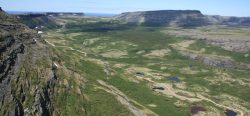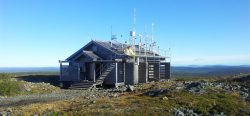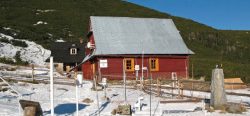Contact Details
Université Laval
Québec, Québec
G1V 0A6
Canada
- Phone: +1 418 656-5507
- Fax: +1 418 656-2043
- Email: cen@cen.ulaval.ca
- Link: http://www.cen.ulaval.ca/bylot/
STATION NAME AND OWNER
The Bylot Island Research Station is owned and run by the Centre d’études Nordiques (CEN: Centre for Northern Studies) and in collaboration with Parks Canada (http://www.pc.gc.ca/index.aspx). The CEN secretariat is based at Université Laval, Québec, Canada.
LOCATION
Bylot Island is located off the northern tip of Baffin Island, Nunavut, Canada. It is accessible through the communities of Pond Inlet (Mittimatalik) and Nanisivik, both found on Northern Baffin Island. The field research covers the south plain of the island (1600 km2), but the research station is located in a large glacial valley at the southwest end of the island (73°08’ N, 80°00’ W).
BIODIVERSITY AND NATURAL ENVIRONMENT
Much of Bylot Island is covered by high mountain peaks and glaciers. The remainder of Bylot Island, and in particular its southern plain, is characterised by extensive low-elevation areas covered by heterogeneous tundraA type of ecosystem in which tree growth is limited by low temperatures. The origin of the word is from from the Kildin Sami word t?ndâr, meaning "uplands" or "treeless mountain tract". In the northern... More vegetation. The vegetation found in the wetlands is characterised by the presence of sedges, grasses, and many brown moss species. In contrast to the wetlands, dryer areas are found on slopes, hills and elevated terraces surrounding the valley lowlands, as well as on the rims surrounding tundraA type of ecosystem in which tree growth is limited by low temperatures. The origin of the word is from from the Kildin Sami word t?ndâr, meaning "uplands" or "treeless mountain tract". In the northern... More polygons. The better drained, dryer soils of these habitats allows for distinct plant communities, including forbs, grasses, and shrubs. These uplands, account for 90% of the south plain surface whereas wetlands account for only 10%. The wetlands of the south plain are a habitat of rare plant quality and productivity for an arcticDefinitions of the Arctic vary according to environmental, geographical, political, cultural and scientific perspectives. Some scientists define the Arctic as areas having a high latitude, long winters, short, cool summers,... More environment. Benefiting from this “polar oasis” are more than 360 species of plants, 10 mammal species, and 74 bird species. Considered as an important site for many migratory birds, Bylot Island was declared a Migratory Bird Sanctuary in 1965. The south plain holds one of the world’s largest breeding colonies of greater snow geese and the wetlands of the Qarlikturvik valley represent their main brood-rearing site on the island. In addition to the geese, other herbivores are the brown and collared lemmings, ArcticDefinitions of the Arctic vary according to environmental, geographical, political, cultural and scientific perspectives. Some scientists define the Arctic as areas having a high latitude, long winters, short, cool summers,... More hare, and rock ptarmigan. The main terrestrial predators are the ArcticDefinitions of the Arctic vary according to environmental, geographical, political, cultural and scientific perspectives. Some scientists define the Arctic as areas having a high latitude, long winters, short, cool summers,... More fox, long-tailed jaeger, parasitic jaeger, glaucous gull, common raven, and snowy owl. Food webA food web is a description of feeding connections in an ecological community (i.e. a group of organisms). Put simply, food webs describe what 'eats' (or more correctly, 'consumes') what.... More relationships are summarised in Gauthier et al. (2011): Ecoscience 18: 223-235. Established in 2001, Sirmilik National Park encompasses most of Bylot Island, except for a few pockets that are Inuit-owned lands. Covering an area of 22 000 km2, this park extends to the northern part of Baffin Island. Sirmilik (which means “place of glaciers” in Inuktitut) reflects the complex of glaciers and ice caps covering most of Bylot Island. Extensive data records are available at: www.cen.ulaval.ca/nordicanad or upon request (cen@cen.ulaval.ca). For requests concerning ecological monitoring data, please contact the lead researcher Gilles Gauthier (gilles.gauthier@bio.ulaval.ca).
HISTORY
The current ecological studies on Bylot Island started in 1988 as a joint collaboration between Université Laval (CEN) and the Canadian Wildlife Service (Quebec region). The initial goals of the study were to initiate a demographic study of the greater snow geese population through a long-term marking program, and to assess the impact of goose grazing on the tundraA type of ecosystem in which tree growth is limited by low temperatures. The origin of the word is from from the Kildin Sami word t?ndâr, meaning "uplands" or "treeless mountain tract". In the northern... More vegetation. However, over the years, the research program has broadened considerably and now includes many other components of the terrestrial ecosystemAll the living organisms (including people) in an area as well as its physical environment, functioning together as a unit. An ecosystem is made up of plants, animals, microorganisms, soil,... More.
GENERAL RESEARCH AND DATABASES
A central theme of the research conducted here is trophic interactions in the arcticDefinitions of the Arctic vary according to environmental, geographical, political, cultural and scientific perspectives. Some scientists define the Arctic as areas having a high latitude, long winters, short, cool summers,... More tundraA type of ecosystem in which tree growth is limited by low temperatures. The origin of the word is from from the Kildin Sami word t?ndâr, meaning "uplands" or "treeless mountain tract". In the northern... More in relation to environmental changes and greater snow goose ecologyThe study of living organisms in their environment, including where they are found and how they interact with their physical environment and with each other, for example through food webs.... More, but also long-term monitoring of animal populations, vegetation and climate of the ArcticThe Arctic is often defined based on climate, for example, the area where the average temperature for the warmest month is below 10°C (50ºF).... More tundraA type of ecosystem in which tree growth is limited by low temperatures. The origin of the word is from from the Kildin Sami word t?ndâr, meaning "uplands" or "treeless mountain tract". In the northern... More, impacts of bird populations and Climate ChangeAccording to the United Nations Framework Convention on Climate Change, climate change is change in the climate of the whole Earth or a region of the Earth that is believed... More on lake ecosystems, and geomorphology of ice wedge polygons. Over the years, the Bylot Island research project has grown into one of the largest and longest ecological studies in Nunavut. Extensive data records are available at: www.cen.ulaval.ca/nordicanad or upon request (cen@cen.ulaval.ca).
HUMAN DIMENSION
No communities are present on Bylot Island. The nearest community is Pond Inlet (Mittimatalik) found on northern Baffin Island, Nunavut, Canada.
ACCESS
The research station is accessible by chartered flights from Pond Inlet (Mittimatalik). Research must be planned well in advance and coordinated with the station’s primary and secondary contacts Gilles Gauthier and Dominique Berteaux (dominique_berteaux@ uqar.qc.ca).























